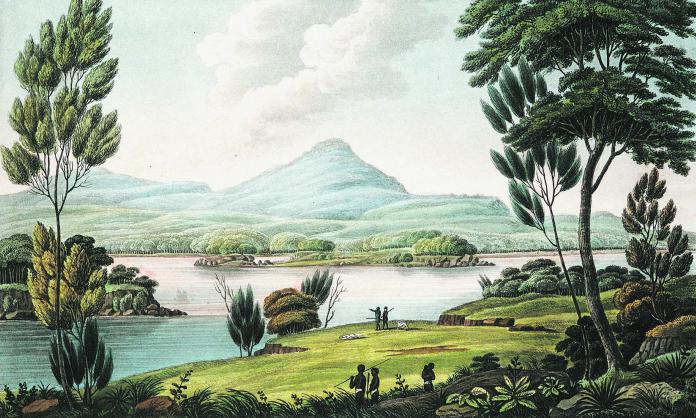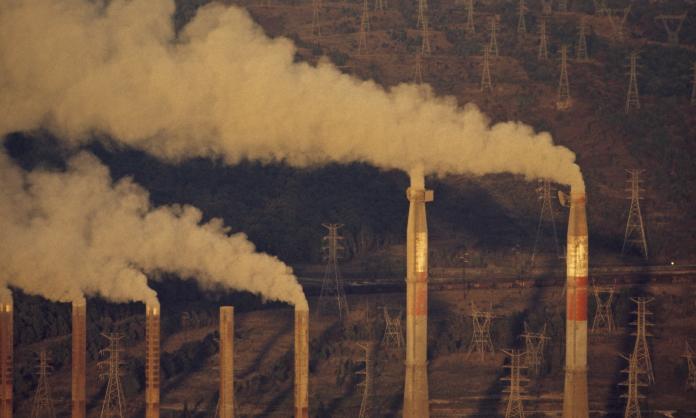When Captain James Cook first surveyed what later became known as Australia, he declared his “discovery” to be “in the pure state of Nature, the Industry of Man [having] had nothing to do with any part of it”. In reality, the “industry of man” had everything to do with the places that Cook most valued. Indigenous people did not live in a “state of nature”—at least, not in any simple way. Rather, they shaped, through their labour, the environment on which they depended.
Indigenous people developed a complicated method of land custodianship resting on what historian Bill Gammage calls “templates”: particular associations of disparate plant species, maintained over decades or even centuries. They selected a notable topographic feature—such as a lake, a mountain, or a rock—and then reshaped the surrounds to complement it, alternating varieties of vegetation to create effects that suited them and the animals they wanted to attract.
Taboos and other cultural prohibitions discouraged the taking of plants and animals in circumstances that might diminish the long-term viability of species; similar obligations ensured that burns were performed only when and where they were required. These methods did more than sustain the population. They generated abundance and did so efficiently: Indigenous people seem to have spent no more than three or four hours each day seeking food.
In pre-capitalist Australia, humans did not despoil nature; they consciously improved it. Within a few years, white settlement changed all of that. Land the colonists had assumed was inexhaustibly fertile became barren clay, exposed to the sun and rapidly eroding. The unmaking of the continent resulted not from human activity so much as the wrong kind of human activity. A relatively tiny number of Europeans prevented a larger number of Indigenous people from maintaining the environment in the way that they’d done for tens of thousands of years.
They did so by introducing capitalism. Today, we take the wage system that underpins capitalism for granted. It appears normal, almost eternal, because we can barely conceive of an alternative. It did not seem normal to pre-colonial people. Historian Henry Reynolds provides a long list of complaints from Europeans about the indifference to wages of local people, who simply saw no reason to labour with the intensity demanded by capitalists.
The problem was neither one of stamina nor of aptitude, but rather pertained directly to their relationship with nature. Accustomed to taking with little difficulty food and other resources from the wild storehouse they’d constructed all around them, they could not recognise any justification for the patterns of work that the Europeans required.
When Indigenous people gathered food, or burned the bush or fulfilled customary obligations, they provided food, clothing and shelter for themselves and those around them, not for a boss or for a distant customer. They were not impelled by an abstraction like money; they were meeting the immediate obligations of necessity, in ways hallowed by tradition and exulted by theology. Their labour—hunting, burning the bush, sowing and collecting plants—combined what the Europeans would describe as work, recreation, worship, art and much else besides.
In Western Australia, the “protector” of Aborigines noted that Indigenous people did not see the necessity of labouring for colonists because they preferred the “precarious subsistence” of the bush and saw their “roving life” as superior to the “habits and customs of civilisation”. He was correct, except insofar as he regarded their subsistence as “precarious”: prior to 1788, the standard of living for Indigenous people seems to have been considerably higher than for most of the English working class.
Indigenous people thought the work demanded by capitalists stripped life of its humanity. They could not comprehend why anyone would accept such monotony, such empty, soulless drudgery, given the bush itself provided the basis for a life of material satisfaction and spiritual enrichment.
European observers tended to explain the Indigenous hostility to wage labour as a product of race or culture. Yet the Australian colony itself provides striking evidence to the contrary, simply because it came into being—at least in part—in response to a very similar transformation within England. Until the early modern period, many people in rural Europe also depended on collective, non-capitalist practices for their day-to day survival—practices that they, too, saw as giving life meaning and value.
Feudalism was, of course, a very different system from that which prevailed in Australia, not least because it mandated a tremendous disparity between the privileged aristocracy and people who possessed neither wealth nor power. But, unlike the capitalism that replaced it, the feudal order recognised reciprocal rights and obligations, including those customs through which peasants collectively tended various natural resources to sustain a community.
Many of England’s poorest relied on the so-called commons: shared lands in which they grazed cattle, collected fruits and berries, and perhaps raised some crops. The management of such areas depended on a social world of rituals, feasts and festivals—structures through which the folk made sense of their often difficult lives. That culture mandated a way of living far more attuned to the natural cycles than what was to come.
From the fifteenth and sixteenth centuries, feudal landowners realised they could make fortunes growing wool for the textile industry, so they forcibly enclosed vast tracts of land previously held in common. The customary systems of land management gave way to an agricultural capitalism that treated the soil merely as a source of profit. Unable to survive in the old ways, displaced people straggled into the cities, whose markets and industry grew on the back of destructive rural “improvement”.
Like the Indigenous men and women uprooted by white settlement in Australia, many of those who could no longer live on the land resorted to begging—and, in some cases, to criminality. The British state responded with viciously punitive legislation. Between 1688 and 1820, the number of offences attracting the death penalty increased from 50 to more than 220. Looking back from 1857, an appalled Charles Phillips wrote, “Every page of our statute book smelt of blood”.
Yet bloodshed was only part of the transformation imposed by the English elite on the mass of the population. The authorities also dealt with the swelling criminal class through transportation—including to the new colony. In a grotesque irony, the dispossession of Indigenous people in Australia can be traced to a similar dispossession in England, with the settlement of the new country driven, at least in part, by the need to build a different order in the old one.
By forcing the rural poor out of their traditional villages, the enclosures created a social layer with no choice but work for a wage. People who previously would have fed and clothed themselves by their own labour suddenly no longer could. That experience was, again, utterly wrenching. The new regime meant that people worked far harder than would have been imaginable previously. In 1200, an adult male in England laboured for an estimated 1,620 hours per year on average; by 1840, the figure stood as high as 3,588. Even more significantly, artisans or peasants displaced from their ancestral communities and into the cities were inducted into an entirely new culture.
Before the industrial system could function properly, the owners of capital needed to normalise conduct markedly at odds with the values most people cherished. The new workers had to arrive punctually; to perform precisely the task needed (and never do anything else); to keep quiet during work hours (rather than chatting, singing, swearing or arguing); to maintain a regular output instead of working in bursts; and to think of nothing but the repetitive duties assigned to them. They had to accept that this new method of labour would occupy most of their time and they had to discard, as obstacles to progress, the traditional habits and customs by which they’d made sense of their lives and tended their country.
The rhetoric of the early English manufacturers about their employees thus replicates, almost exactly, the attitude of colonialist employers to Indigenous people. The factory owner Samuel Greg Junior vented about the “restless and migratory spirit” of factory hands; the entrepreneur Thomas Arkwright bemoaned the difficulty in training staff “to renounce their desultory habits of work”.
In a revealing metaphor, mill managers described the experience of subjecting the locals to the long confinement of the factory as “like putting a deer in the plough”, almost as if, in harnessing the populace to the wage system, they were domesticating nature itself.
As in Australia, religion facilitated the required socialisation, with employers funding churches, chapels and Sunday Schools in every village and town centre, on the basis that ministers preached a gospel of obedience. As in Australia, children were believed more susceptible than their parents, with the philosopher John Locke opining they could begin work from the age of three.
In both Australia and England, the acceptance of wage labour came from the destruction of other options. In both countries, the old order was shattered, in part by physical violence, since the new regime ultimately relied on soldiers with guns. Expelled from their lands and thus unable to feed and shelter themselves in their customary manner, people either accepted capitalist discipline or else became entirely destitute.
We’re accustomed to acknowledging the relationship between Indigenous society and the land, a relationship that enabled humans to sustainably manage an immense continent over a vast time frame. But, even in feudal England, ordinary people valued their direct engagement with nature too, and mourned deeply its destruction. John Clare, the poet of the enclosures, explained: “Each little tyrant with his little sign / Shows where man claims, earth glows no more divine”.
For Clare, closer than we are to the transition between social orders, capitalism disenchanted the land, profaning the previously sacred ritual by which people had once related to their environment. New priorities were forced, painfully and brutally, on the bulk of the population, in ways that made environmental stewardship impossible and facilitated the crisis we now face.
Today, as the temperatures vault year upon year, we can easily think of humanity as fundamentally hostile to nature. Yet, in historical terms, we’ve lived as we do now for the merest blink of an eye. It is the devastation wrought since 1788 that is anomalous, not the tens of thousands of years of stewardship that preceded it.
From the technological world of the 21st century, we cannot, of course, return to the conditions that prevailed in a pre-1788 Australia. But that’s not the point. The remarkably rapid destruction of the landscape created by Indigenous people was not brought about by modern machines. On the contrary, the settlers ruined the land with distinctly low-tech methods. The problem was not technology, but a social system that deployed technology in certain ways, replacing the conscious choices of humans with the blind agency of capital.
For 50,000 years, Indigenous Australians enhanced the land on which they lived. Their example, and that of other native peoples, shows an ecological society to be possible, not some kind of dream or utopia.










